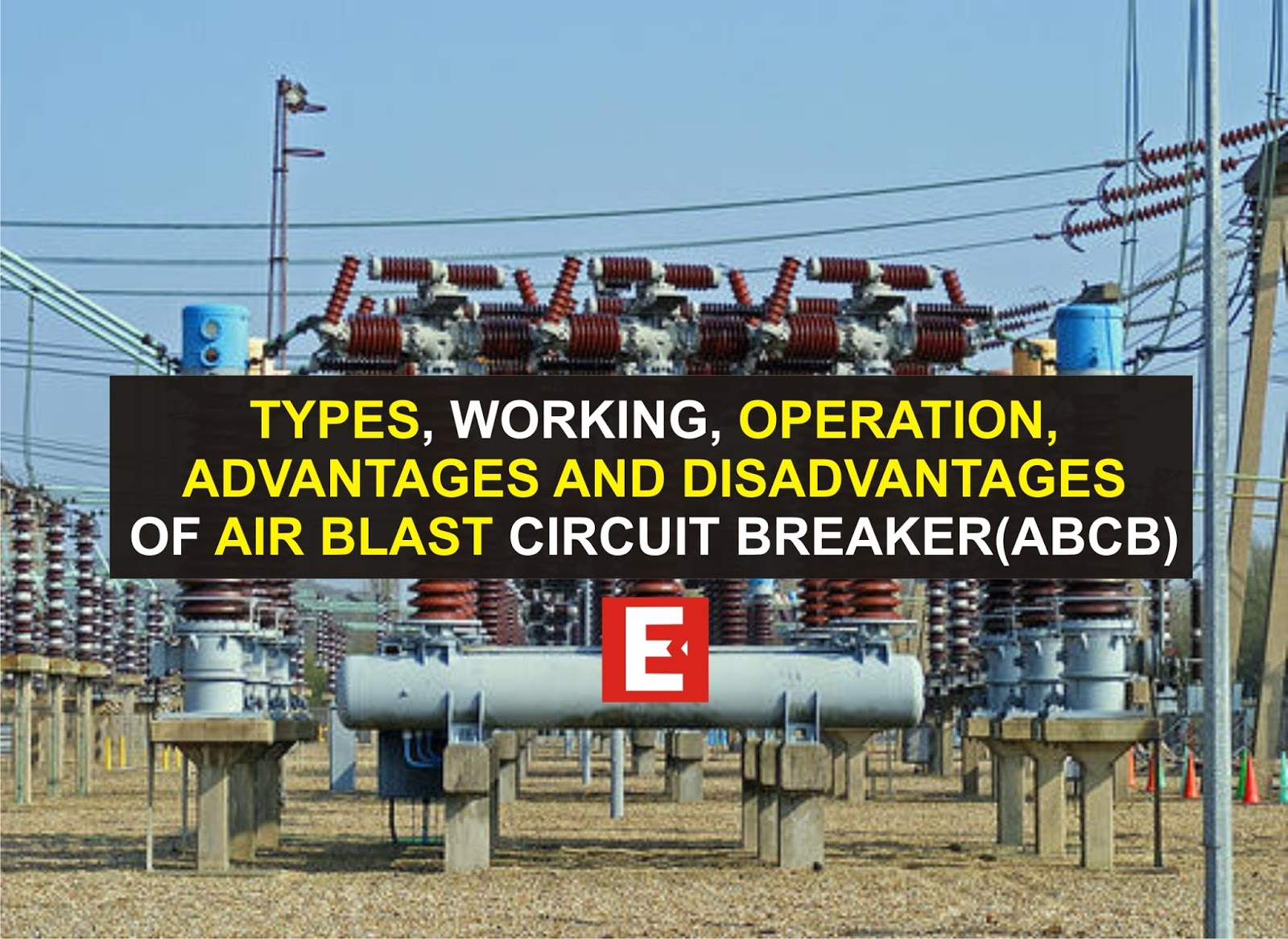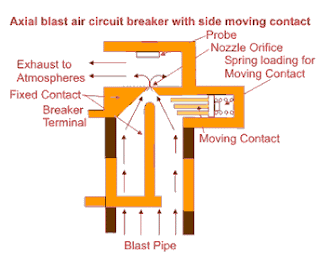As we said earlier that there are mainly two types of Air Circuit breakers, plain air circuit breakers, and air blast circuit breakers. But the latter can be subdivided further into three Different Categories.
- Axial Blast Air Circuit Breaker.
- Axial Blast Air Circuit Breaker with side moving contact.
- Cross Blast Air Circuit Breaker.
Axial Air Blast Circuit Breaker
In the axial blast Air Circuit Breaker, the moving contact is in contact with fixed contact with the help of a spring pressure as shown in the figure. There is a nozzle orifice in the fixed contact which is blocked by the tip of the moving contact at the normally closed condition of the breaker. When a fault occurs, high-pressure air is introduced into the arcing chamber. The air pressure will counter the spring pressure and deforms the spring hence the moving contact is withdrawn from the fixed contact and the nozzle hole becomes open. At the same time, the high-pressure air starts flowing along the arc through the fixed-contact nozzle orifice. This axial flow of air along the arc through the nozzle orifice will make the arc lengthen and colder hence arc voltage becomes much higher than the system voltage which means system voltage is insufficient to sustain the arc consequently the arc is quenched.
Axial Air Blast Circuit Breaker with Side Moving Contact
In this type of axial blast air circuit breaker, the moving contact is fitted over a piston supported over a spring. To open the circuit breaker the air is admitted into the arcing chamber when the pressure reaches a predetermined value, it presses down the moving contact; an arc is drawn between the fixed and moving contacts. The air blast immediately transfers the arc to the arcing electrode and is consequently quenched by the axial flow of air.
Cross-blast air Circuit Braker
The working principle of the cross-blast air circuit breaker is quite simple. In this system of air blast circuit breaker the blast pipe is fixed perpendicular to the movement of moving contact in the arcing chamber and on the opposite side of the arcing chamber one exhaust chamber is also fitted at the same alignment as the blast pipe, so that the air comes from blast pipe can straightly enter into exhaust chamber through the contact gap of the breaker. The exhaust chamber is spit with arc splitters. When moving contact is withdrawn from fixed contact, an arc is established in between the contact, and at the same time high-pressure air coming from the blast pipe will pass through the contact gap and will forcefully take the arc into the exhaust chamber where the arc is split with the help of arc splitters and ultimately arc is quenched
These types of air circuit breakers were used for the system voltage of 245 KV, 420 KV and even more, especially where faster breaker operation was required.
Air blast circuit breaker advantages
- There is no chance of fire hazards caused by oil.
- The breaking speed of the circuit breaker is much higher during the operation of the air blast circuit breaker.
- Arc quenching is much faster during the operation of an air blast circuit breaker.
- The duration of an arc is the same for all values of small as well as high current interruptions.
- As the duration of an arc is smaller, so lesser amount of heat is realized from the arc to current-carrying contacts hence the service life of the contacts becomes longer.
- The stability of the system can be well maintained as it depends on the speed of operation of a circuit breaker.
- Requires much less maintenance compared to oil circuit breakers.
Disadvantages of air blast circuit breakers
- To have frequent operations, it is necessary to have a sufficiently high-capacity air compressor.
- Frequent maintenance of the compressor, associated air pipes and automatic control types of equipment is also required.
- Due to high-speed current interruption, there is always a chance of a high rate of rise of re-striking voltage and current chopping.
- There is also a chance of air pressure leakage from air pipes junctions.







